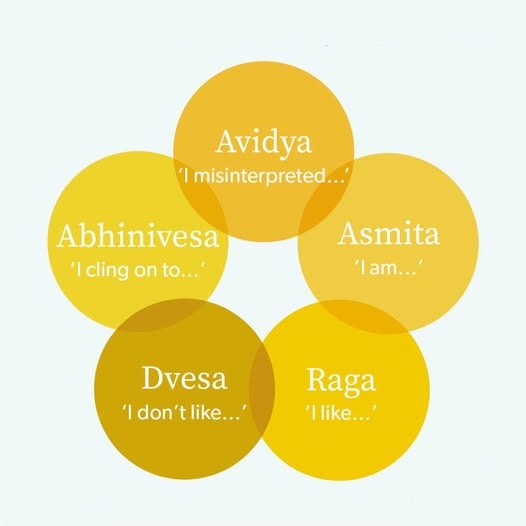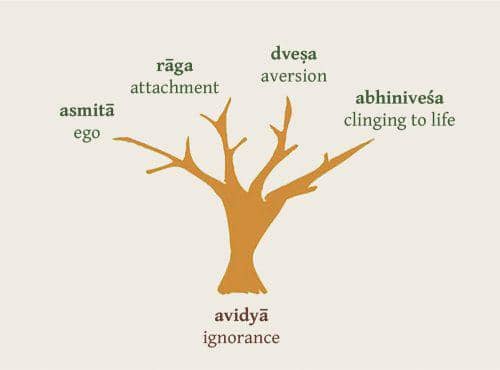The 5 Kleshas – Barriers on the Path of Self-Realization
- Blog
- /
- Yoga Philosophy and Spirituality
- /
- The 5 Kleshas –...

Understanding the 5 Kleshas in Yoga Sutras
The world today often seems like a graveyard of buried emotions, shattered morals, and lost self-realization. Discontent and misery pervade many lives as people struggle with the false narratives surrounding their existence, goals, and happiness. According to the Yoga Sutras by Sage Patanjali, the root of worldly miseries can be traced to five main causes known as Kleshas. Understanding these Kleshas is crucial for personal growth and global peace.

The 5 Type of Kleshas in Yoga
1. Avidhya (Ignorance or Lack of Discretion)
Avidhya, the first Klesha, signifies deep-rooted ignorance and incomplete knowledge. This stage represents an initial lack of awareness, similar to that of a child. Ignorance perpetuates a life focused solely on the physical body, leading to various miseries and failures. To overcome Avidhya, one must seek deeper understanding and acknowledge the soul’s true needs.
2. Asmita (Ego & Pride)
Asmita, the second Klesha, involves ego and pride, which can destroy relationships and peace. Ego acts as a destructive force, leading to conflict and regret. When ego dominates, it disrupts harmony and fosters negative behavioral patterns. To counteract Asmita, it’s important to cultivate humility and seek harmonious connections with others.

3. Raga (Attachment)
Raga, the third Klesha, refers to attachment and its impact on our well-being. Excessive attachment to people or things can lead to regret and sadness when these attachments are lost. Learning to let go and understanding the temporary nature of life can help manage Raga and promote emotional resilience.
4. Dwesha (Hatred)
Dwesha, the fourth Klesha, embodies hatred and its consequences. Hatred creates negative karma and damages relationships. It fuels a cycle of anger and dissatisfaction. Recognizing that peace cannot arise from hatred and working to dissolve these negative emotions is essential for personal and communal harmony.

5. Abhinivesha (Fear of Death)
Abhinivesha, the final Klesha, is the fear of death and its impact on life. Death is a natural part of existence, and fearing it prevents us from living fully. Embracing the reality of death as a transition rather than an end can transform our approach to life, allowing us to live more fully and with less fear.
Also Read: What is Bhakti Yoga? A Heartfelt Path of Love, Prayer, and Kindness
Conclusion
By understanding the 5 Kleshas—Avidya, Asmita, Raga, Dwesha, and Abhinivesha—it becomes easier to recognize the patterns that create suffering in daily life. Through mindful practice, self-reflection, and yoga, these obstacles can be gradually reduced, leading to greater mental clarity, inner peace, and personal growth. Rishikul Yogshala encourages integrating these teachings into everyday life to support a balanced mind and a more harmonious journey toward self-realization.
FAQ
Q: How do the 5 Kleshas affect daily life?
Ans: The 5 Kleshas can cause suffering, stress, emotional imbalance, and distractions, preventing mental clarity and spiritual growth.
Q: Are the 5 Kleshas the same for everyone?
Ans: While everyone experiences these Kleshas, their intensity and impact vary depending on an individual’s personality, habits, and awareness.
Q: How can I recognize the 5 Kleshas in myself?
Ans: Observing repeated patterns of attachment, aversion, ego-driven behavior, fear, or ignorance in thoughts and actions can help identify the Kleshas within yourself.
Q: Is studying the 5 Kleshas only for advanced yogis?
Ans: No, understanding the 5 Kleshas is helpful for beginners and advanced practitioners alike, as it guides personal growth, mindfulness, and emotional balance.

MEDITATION, INSPIRATIONAL AND SPIRITUAL GUIDE
Yogi Gangesha Chaitanya is a master of Yoga Philosophy, Meditation, Pranayama, and Spiritual Guidance, trained under Swami Rama and renowned institutions like the Himalayan Tradition and Sri Aurobindo Ashram. With expertise in Kundalini Yoga and meditation, he mentors students in 200-hour and 300-hour Yoga Teacher Training programs, guiding them toward inner awareness, spiritual growth, and a deeper understanding of yoga.
View Instagram Profile









